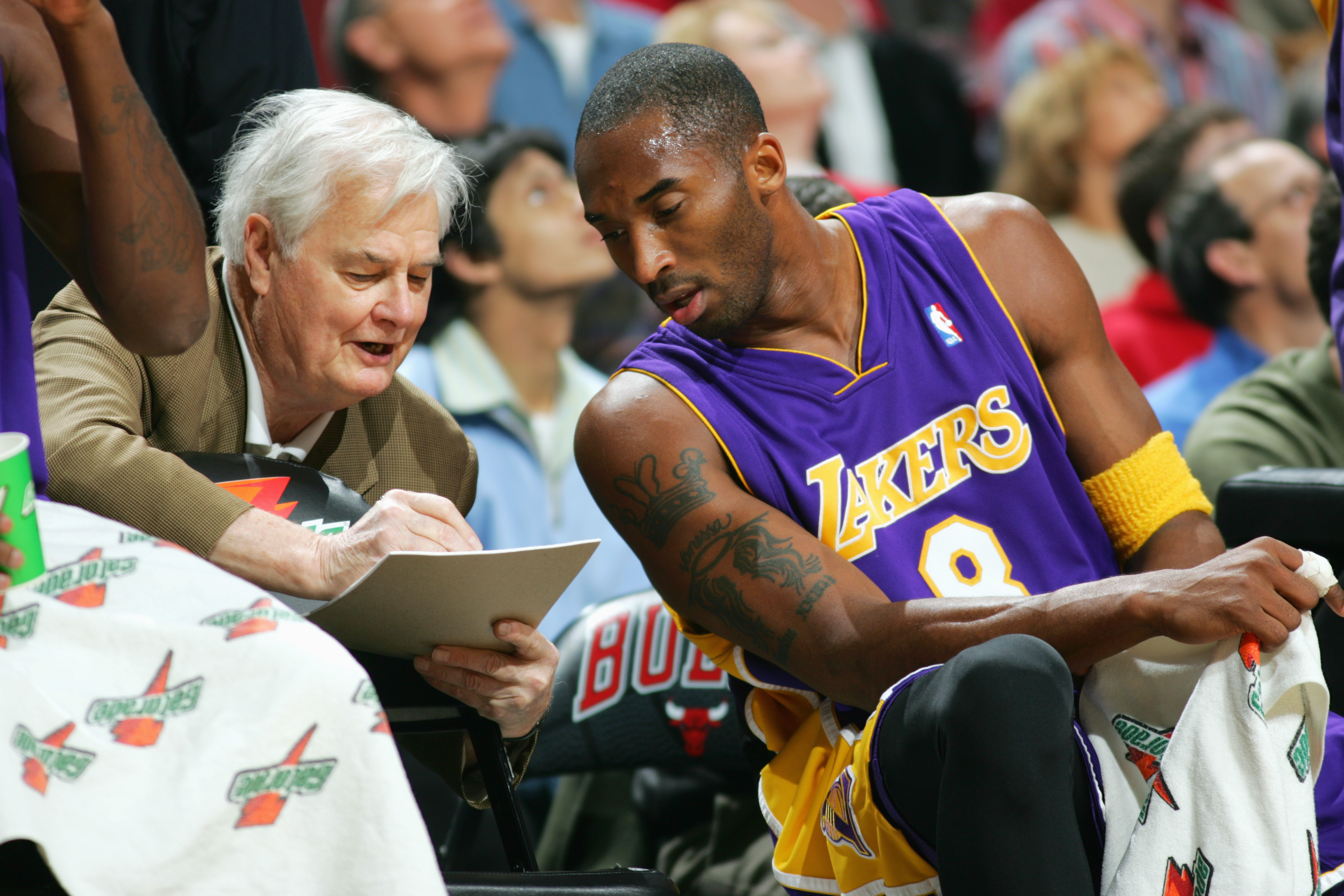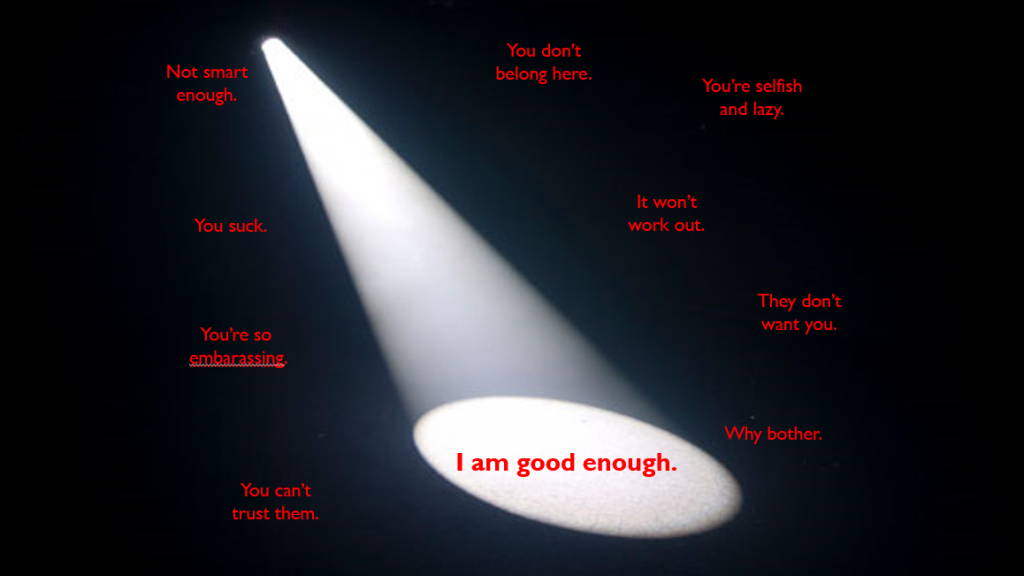Thoughts are mental representations that are the building blocks for ideas, images, words, beliefs, judgments, memories, and fantasies. Thoughts form schemas or “mental maps” to help us adapt and navigate the complex world that we inhabit. Thoughts can be a boon or a curse depending on what function they serve in our lives. The following section provides a model (Think-Mind) that outlines strategies to manage thoughts in a constructive way, especially when we fall into negative thought spirals that keep us trapped in our heads.
Quick Links
- Tame your ego
- Hold with equanimity
- Incorporate your body
- Nurture peace of mind
- Know your thoughts (but don’t believe them)
- Mindfully observe
- Interpret from multiple perspectives
- Narrate wisely
- Disrupt automatic negative thoughts
Tame your ego
There is a self-important and self-centered quality to an inflated ego that entices us with grandiose fantasies which sets us up for disappointment when we fail to achieve its lofty aspirations. An ego that over-steps has us seeking more and more, and pre-occupies us with incessant thoughts, “I am not good enough” or “what do other people think about me?” Thus, it is helpful to put the ego in its place, that its function is to serve us, not the other way around.
Call out the ego. Recognize ego-driven thoughts when they arise, such as grandiose fantasies, inflated self-importance, thinking you are better or worse than others, thinking that others revolve around you, overexaggerating achievements, thinking you can control the uncontrollable, and personalizing external events that are not about you. It may be helpful to say something to extent of “there’s that ego again,” which in turn makes conscious the separation between your sense of self and the ego.
Beginner’s Mind. Remember that feeling when you first started something you were passionate about, the sense of awe and wonder, a curiosity, and an openness to learning. There is also a humility to a beginner’s mind that keeps us grounded. From my experience, the more I learn about a particular subject, I realize I know so little of it. There is wisdom in knowing what we don’t know, and the humility that comes with being a beginner offsets complacency and keeps the motivation alive to keep us growing.
Growth mindset. A growth mindset is oriented to ones’ intentions and effort versus the outcome of a particular performance, such as feeling satisfied for trying your best despite a failure. A growth mindset recognizes that failure is part of the process. A growth mindset is captured in Warren Buffett’s notion of the “inner scorecard” in which the reference point for ones’ progress should not be comparing yourself with other people but with yourself from an earlier period of time, such as a where you were one year ago or when you first started a process. The following is a TED talk on growth mindset by Carol Dweck.
Accept failure as a natural part of the process. To be human means to be imperfect, so mistakes and failures are inevitable. Failures can happen due to bad luck, or may be an indicator that the task at hand is above your current ability level. However, the failure indicates that you took the risk to challenge yourself, and that experience of challenge can help you grow and reinforce resiliency.
Set boundaries with people who overly flatter. To a certain extent, we all have a need for praise and recognition. However, when the praise is excessive and/or undeserved, it can have the detrimental effect in inflating our egos, which in turn removes us from reality. Over flattering may also be a cover for deeper insecurities in the relationship (e.g., avoidance of conflict). Jim Rohn, a successful entrepreneur, says “affirmation without discipline is the beginning of delusion.”
Don’t identify with success or praise. Tex Winter is the architect of the triangle offense behind the incredible success of such NBA legends as Michael Jordan, Kobe Bryant, and Phil Jackson. As the man behind the curtain, Tex Winter is credited with 9 NBA championships, yet he found a way to stay grounded and humble throughout the process. One of his famous quotes is “You’re only a success for the moment that you complete the successful act,” which treats success as a transient state that is not be identified with.

Gratitude practice. A daily gratitude practice is a secular form of “count your blessings,” to remind yourself of the things you may be taking for granted. A commonly recommended gratitude practice is contemplating at least three things at the end of each day of things you are grateful for. Even if you have a bad day, you can look for the silver linings, such as enjoying the warmth of sunlight on your skin or feeling acknowledged when a stranger says hello to you. To provide additional perspective, you may contemplate, “how many people in this world would be grateful to have the day you just had?”
Take care of something. Within reasonable limits, caring for something or someone can be rewarding, especially when your care is received with appreciation, and helps you be more attune to the needs and feelings of others. Caring for something can take the form of growing a plant, taking care of a pet, or volunteering to serve those less fortunate.
Engage in a purpose bigger than yourself. It may be helpful to look beyond your individual needs and interests, and contribute to a cause or a collective need that is larger than yourself. Jordan Peterson states that people tend to be less self-conscious when they engage in purposeful work. Going beyond individual interest re-orients life towards one of meaning and purpose, which are forces that can withstand the greatest of adversities. Nietzsche says “He [sic] who has a why to live can bear almost any how.”
Hold with equanimity
Our thoughts can manifest in extremes, such as all-or-none thinking, over-generalizing, and catastrophizing. When our thoughts sway to the extreme, we lose the ability to examine issues from a balanced perspective that is grounded in reality. Cultivating equanimity allows us to be more flexible and open-minded in our thinking.
Recognize that indifference is the near enemy of equanimity. From a Buddhist perspective, Jack Kornfield refers to “near enemies” as a quality that disguises itself as another quality but is actually the opposite of it. The near enemy of equanimity is indifference. On the surface, indifference may take the form of neutrality; however, it is also a state of apathy and detachment. Kornfield says “true equanimity is not a withdrawal; it is a balanced engagement with all aspects of life.”
Hold opposing views at same time. According to Marsha Linehan, a wise mind is able to hold opposing views at the same time, shifting from a “no, but” to a “yes, and” mindset. A core element of Linehan’s DBT model is that opposite ideas can both be true at the same time. Opposing views represents the duality of life that is represented in the Yin-Yang symbol. Holding both sides allows us to connect with the whole of experience, both the good and bad, the pleasant and unpleasant.
Avoid over-intellectualizing. Equanimity involves the integration of both the rational and emotional mind. When we get stuck in our heads, we can over-intellectualize, detaching us from our emotions and bodily sensations which are also sources of knowledge that are just as valuable as reasoning. People often over-intellectualize as a defense mechanism from feeling difficult emotions or bodily sensations. Despite this dynamic, it is ironic that people who over-intellectualize often have a “know-it-all” attitude,” when in reality they are limiting their knowing.
Equanimity meditations. The following are meditations that you can practice to cultivate equanimity. My personal favorite is the mountain meditation that has you imagine being centered like a mountain despite changing conditions (e.g., changing seasons).
Incorporate your body
The mind is the activity of the brain and the brain is a major organ of the body, thus, whatever is good for the body is good from the brain. Furthermore, brain scans show that physical activity activates more parts of the brain compared to when we are sedentary. Thus, brain health and body movements can improve the quality of our thinking and promote neuro-integration.

Incorporate movement. When Scrooge McDuck, from the old Duck Tales cartoon, was faced with a problem, he would pace around in his “worry room” until he had a light bulb moment. When we are in a thought spiral while sedentary, feels like our insides is like a pressure cooker. Movement allows us to circulate the mental energy, and activate other parts of the brain (e.g., sensory-motor cortex) so that we are approaching the problem in a more neuro-integrative way.

Stay present in the body. The mind can time travel to the past, the future, and into fantasies and get stuck there, which in turn dissociates us from the present reality which is the only moment in time we have true agency and freedom to impact change in our lives. Unlike the mind, the body is limited to the physical dimension. Thus, by focusing and being attune to our bodies, we can anchor our mind to the present moment.
Five senses grounding. A practice that can help you get out of your head and into your body is the five sense grounding exercise. This exercise is helpful when feeling anxious or at the early stages of a panic attack. The rationale is that what is happening in the present moment is oftentimes more neutral (e.g., all that is happening this moment is you reading this resource guide), as opposed to what’s happening in your mind, which can imagine all kinds of worst-case scenarios. Please see Five Senses Grounding section for instructions.
Identify your brain states. Research in the field of neurofeedback training has differentiated brain wave patterns that are associated with different states of mind. Outside of the neurofeedback context, it is unrealistic to identify your actual brain waves without elaborate technological devices/sensors and procedures involved; however, one can intuit the brain waves based on your experience of your mental states per the descriptions in the following graphic. From this perspective, it is helpful to match the appropriate brain state to the activity at hand, such as being in an alpha brain state while on vacation, and low-beta state when addressing problems in our lives.

Sleep Hygiene. Sleep serves important cognitive functions, such as memory consolidation and removal of waste products in the brain. When we are sleep deprived, our mind is not functioning optimally, resulting in attentional difficulties and inability to manage unwanted thoughts. Please refer to the sleep resources section for improving sleep hygiene.
Brain foods. In computer science there is a saying, “garbage in, garbage out.” Similar to the body, the quality of the foods that we consume can affect brain health. The following are food items that can enhance brain health.
- Avocados. Contributes to healthy blood flow and lowers blood pressure.
- Blueberries. Antioxidant associated with improvements in learning, thinking, and memory.
- Broccoli and Cauliflower. Source of choline which aids brain development.
- Celery. Source of luteolin which calms inflammation in the brain.
- Coconut oil. Source of ketone bodies which help renew and restore neurons and nerve functions.
- Dark chocolate. Stimulates production of endorphins, and helps improve mood.
- Freshly Brewed Tea. Modest amount of caffeine can enhance focus and mood.
- Turmeric. Yellow spice in curry that boosts memory and stimulate production of new brain cells.
- Walnuts. Contains neuroprotective compounds such as vitamin E, folate, melatonin, and anti-oxidants.
- Wild Alaskan Salmon. Rich in essential omega-3 fatty acid, which helps fight inflammation in body and brain.
Avoid substances that cloud your thinking. Substances may alter our state of consciousness. When use responsibly, substances can provide a novel and/or recreational experience. However, substances can be abused and/or result in a dependency that has detrimental effects on our cognitive functioning. On related note, it is helpful to be informed about the negative side effects of certain psycho-tropic medications that affect your cognitive functioning. Sometimes the side effects may be worse than the benefits.
Prioritize physical safety. Stephen Porges’ research on the brain’s “neuroception” shows that our body is constantly scanning the environment for danger and prioritizes safety and survival above all other functions, such as learning, creativity and socializing which may actually be more useful in resolving modern life problems. These functions take a back seat to our pre-programmed fight, flight, and freeze responses that evolved more to protect us from physical dangers. Given the negativity bias towards threats of physical danger, most cognitive strategies may have a limited effect until safety is re-established. Establishing safety may be easier said than done, such as for those living in households with abuse or DV, and/or unsafe neighborhoods. In these cases, it may be helpful to reach out to community resources and social advocates, as well as not blaming or being critical of yourself for when your efforts to self-regulate are ineffective.
Bilateral stimulation. Discovered by Francine Shapiro, bilateral stimulation (BLS) is the basis of EMDR therapy to help clients process traumatic events through left-right rhythmic stimulation that is usually visual (eye movements), auditory (alternating tones), and/or touch (finger tapping). BLS has been found to decrease worrying, and increase attentional flexibility, allowing thoughts to be more fluid as opposed to fixated, such as when we are caught up in a negative thought spiral. While it is recommended to seek out an EMDR therapist if the intent is to use BLS to process trauma, BLS can also be helpful for garden variety anxious thoughts. Just 20-30 seconds of BLS at a time can help you process your thoughts. An accessible form of BLS is the butterfly hug which is demonstrated in the following video.
Nurture peace of mind
An unquiet mind can be a source of agitation and distress, tormenting us with incessant judgments, worries, and demands. For many, it may be out of their control to quiet the mind, such as for those struggling with PTSD or bipolar disorder. Chaos, pain, and suffering are aspects of the human condition. While these conditions are inescapable, it may be helpful to cultivate sanctuaries of peace and calm in your life to provide momentary reprieve.
Give your mind a rest. The brain is a resource hog. The brain is about 2% of the body’s total weight, but consumes about 20% of the body’s energy. According to this Time article, people burn about 320 calories on a typical day from thinking, but different mental states and conditions can consume more or less. These findings may explain why individuals in the throes of a major depressive episode report feeling so tired despite them laying around most of the time. Even though their bodies are sedentary, their minds may be active with self-defeating thoughts. Along this line, Freud referred to depression as “aggression turned inward.” Given the energy draining quality of an over-active mind, it may be helpful to give your mind a rest by engaging in non-mental activities that take you out of your head and into your body.
Slow down your thoughts. There is a rapid and disorganized quality to our thinking when we are in a dysregulated state, such when we experience intense fear. To regain stability, it may be helpful to slow down your thinking by engaging in slow and steady activities, such as deep breathing, walking or moving slowly, or listening to silence.
Consume less information. We live in the world of the 24/7 news cycle that pummels us with a constant stream of information right at our finger tips, ranging from tragedies affecting people across the globe as well as irrelevant pieces of information like what Kim Kardashian had for breakfast. “Ignorance is bliss” is becoming harder to come by. All that information we consume needs to be processed which takes a toll on the brain. Less information means that there is less stimulus for our minds to react to. Thus, it may be helpful to limit your news consumption, pair down your bookmarks, unsubscribe to irrelevant forums, and turn off notifications.
Increase signal to noise ratio. When there is a lot of background noise, we need to raise our voice to get our message across. Similarly, when there is a lot of noise in our mind (e.g., worrying), our rational and constructive thoughts need to be “loud” for the signal to get through. Thus, it may be helpful to set boundaries around people and situations that create a lot of noise in your mind. This is important because inner wisdom is often communicated in whispers. We need to bring down the noise floor to attune to our deeper self.
Play peaceful and rhythmic music or voices in the background. Our mind can passively absorb the peaceful energy of sounds contributing to an inner state of peace and calm. One of my favorite presets on my Pandora radio is the relaxation channel. Furthermore, you can play a podcast of a voice that you find soothing. For me, I find Jack Kornfield’s voice quite soothing and routinely have him play on my car radio while driving. Even though I am not always listening to his words, I can feel his energy.
Chanting. Bessel Van der Kolk extolls the value of the age-old practice of rhythmic chanting (e.g., “Om”) that can increase heart rate variability, integrate the mind and body, and helps us connect with others when done in group setting. Chanting has become lost in modern society besides certain yoga or religious practices. Here is a Youtube video of a choir chanting “Om” that you can chant along with.
Coloring. Often seen as a kid’s activity, coloring can be helpful for adults as well. Coloring can be an activity that connects with your inner child reinforcing an integrated sense of self. Furthermore, when we are in a negative thought spiral, coloring can transition us from a fearful mind set, towards other mindsets associated creativity, sensory-motor (e.g., hand movements, touch), and visual (e.g., seeing a wide range of colors). There are a plethora of children and adult coloring books that can be found online, including ones that are marketed for mental health purposes. An affordable method is using google images and selecting “line drawing” under the Tools/Type setting, which can then be printed out for coloring.
Gardening. In Jordan Peterson’s take on the Bible’s creation story, the garden symbolizes the balance between order and chaos. Peterson equates too much order to tyranny and too much chaos to anarchy. From this perspective, gardening may be a way to balance out the ordered and chaotic qualities of the mind, such as the ordered activity of planting, watering and taking care of plants, and the chaos of unpredictable weather patterns and weeds/insects that infiltrate the garden.
Connect with nature. Mountain hikes forces me to be present and engage, a wrong mis-step can result in me tripping and hurting myself, falling off a cliff, or getting wet during a river crossing. Furthermore, there is an expansiveness to nature that creates a sense of awe and wonder, which in turn makes my thoughts feel tiny in comparison. While the benefits of nature are many, accessing nature may be difficult especially for those living in urban settings. Thurs, it may be helpful to surround yourself with photos of nature and outer space, listen to recorded nature sounds, and occasionally going outside at night to do some star gazing.

Know your thoughts (but don’t believe them)
Tara Brach pleads, “don’t believe your thoughts, don’t believe your thoughts.” Our thoughts can lie to and manipulate us, often on such regular basis that we believe them to be true due to normalization. For example, we may have internalized messages as children that resulted in certain beliefs about ourselves (e.g., “not good enough”) and the world (e.g., stereotypes) that either not true or over-simplified.
Don’t buy into your fears. There is an illusory quality to fears and anxiety that overestimates negative outcomes, and undermines our own strengths and ability to cope. Oftentimes the belief “I am not good enough” is based on a fear of not being good enough, versus it actually being true. When we examine this false belief objectively, we are able to discern that the belief is arbitrary and over-simplified, such as it being based on some others’ projections. Furthermore, we may over-generalize a failure experience thinking that this one transient experience defines the whole of who we are or will always be the case.

Say your thoughts out loud. Oftentimes thoughts arise in a half-coherent form, such as it being a mish-mash of incomplete ideas. Finding the right words to describe your thoughts, and articulating them to yourself can help you flesh out the thoughts and examine them with better clarity. For myself, a daily practice of saying out my thoughts is during my morning prayer time in which I verbally say out my thoughts to God.
Journaling. Journals are a repository for our private thoughts and feelings, including ones that are too shameful to share with others. Akin to the confidentiality found in therapy, journaling allows us to be attune to the darker parts of our psyche, as opposed to being blind to the shadows that lurk within our unconscious. Furthermore, journaling serves as autobiographical function, in case you ever want to write your memoirs, face historical traumas that you are now ready to face, or just make sense of how you got to become the person you are today.
Schedule time to worry. Worries know no boundaries, and they often pop-up during times you are not in a position to do anything about them. They arise in bed interfering with your sleep, during performance situations disrupting your focus, and even when you are trying to have fun or relax. Thus, it may be helpful to enforce time boundaries around your worrying by scheduling time to worry. When your mind automatically worries, you can respond by telling yourself that you’ll deal with the worries at the scheduled time.
Worry session. Write out your worries in a stream of consciousness. Afterwards, read over what you wrote and examine to what extent these worries are realistic or likely to happen; how important and urgent it is for you to act on them; and how much control you have over them. Based on your analysis of your worries, identify a response that is consistent with the nature of your worries, such as taking action steps for worries that are real and important, prioritizing worries that are urgent, and letting go of and seeking support for worries that you don’t have control over or likely not to happen.
Investigate origins. We may internalize messages about ourselves and the world when we are young that may not be true or helpful. For example, some people may internalize negative messages such as “I am not worthy,” “I am to blame,” or “I am not smart enough” before we are old or mature enough to know who we really are, and stand up for ourselves. Thus, it may be helpful to understand the origins of your self-defeating thoughts and know the experiences and dynamics from which they arose.

Incorporate different frameworks. Psychologists love models. There are models for all kinds of psychological processes. A model is basically a framework that organizes thoughts and behaviors in a meaningful way. Models can serve as a compass when going through difficult processes, such as Kubler Ross’ stages of grief model. Perhaps not the best metaphor, but a framework may be like water pipes in a house, that directs the flow of water where it needs to go. However, when pipes are faulty, there can be leaks, flooding, and mold that grow from the water damage. Like robust pipes, frameworks can direct your thoughts in constructive and organized way.
Mindfully observe
Some cultures describe the presence of a “third eye” that is able to observe our internal states. It is no mere coincidence that these cultures locate the third eye on the forehead, which is also the location of our pre-frontal cortex which is the seat of our conscious thinking. Our mind has the meta-cognitive ability to observe our thoughts, which gives us the ability to shift from being a subject of our thoughts, to an objective observer, “the one who knows.”
Label the type of thought. To practice and reinforce getting into the habit of observing our thoughts, you can label the thought you are having, such as “oh, there is a judgment…there is a worry…there is a criticism.”
Notice the extent to which you are identified with your thoughts. Even though our thoughts and beliefs may not be true, we may still buy into them as if they are true, perhaps we because have not learned another way to thinking. Acceptance and Commitment Therapy encompasses various cognitive defusion techniques to help create distance between ourselves and our thoughts and feelings.
Recognize that thoughts are transient states. Just like emotions, thoughts are transient states that come and go and pass through us. You may have experienced having one thought one moment, and then a completely different thought just moments later. Thus, it is helpful to not put too much stock into thoughts and let them pass through you until you observe a thought that is particularly worthy of your attention.
Observe the impact of our thoughts on the body and heart. The ABC model of CBT has clients examine the antecedents, beliefs, and consequences of a particular event. The consequences of our thoughts or beliefs may be physical or emotional in nature, such as increased heart rate and tightness in the chest, and feelings of hopelessness.
Mind like the sky meditation. A popular metaphor in mindfulness is that your mind is like the vast sky, and thought are like clouds that pass through. The following is a meditation that has you visualize this metaphor to help you be more attune to the true nature of your mind.
Interpret from multiple perspectives
The Love Actually version of Joni Mitchell’s Both Sides Now is hauntingly beautiful. Her voice etched with the wisdom of age gives credence to the notion that our experience of “love” and “life” is dependent on the perspectives we take.
Perspective taking. Given the transient nature of emotions, they will pass through you in time. Thus, it is helpful to zoom out and look at your emotional difficulties from a larger perspective. To this end, I usually recommend a perspective taking exercise called “Take Five,” in which you first write out a current difficulty, and then examine this issue five weeks from now, five months from now, and five years from now.
See the bigger picture. Sometimes we miss the forest for the trees. The struggles you are currently going through may be a one part of a larger process. Seeing the bigger picture reminds us of what all the pain and suffering is for. Thus, it may be helpful to periodically revisit your long-term goals and place your current struggles in the context of the bigger picture.
Get feedback from others. Our perspectives are limited to our existing schemas that were formed based on what was normative in our lives. For someone who grew up in an unsafe family environment, their mental schemas may be calibrated towards distrusting others, even when a stranger is being genuinely kind to them. Thus, it may be helpful to get feedback from trusted others to see how they see things from their perspective.
Inner child. While children depend on adults for care and protection, children can protect us from our inner demons of cynicism and a hardened, closed off heart. They remind us of what is innocent, true, and pure in life. While a child’s imagination is full of “scary monsters,” connecting with your inner child may be a source of awe and wonder, spontaneity, and playfulness. Seeing the world from eyes of child can be our saving grace. One way to start the process of connecting with your inner child is posting a photo of when you were young in an eye-catching location and spending a few moments each day attending to it.
Future wiser self. Visualize yourself several decades years into the future. Imagine in great detail what your future wise self would be like, such as what kind of values and beliefs, relationships, and person you would be. From this perspective, imagine how your future wiser self would perceive your current situation, and what kind of advice they may impart. You may consider fleshing out your future wiser self more concretely by playing around with the Faceapp (IOS, Android) that allows you to simulate what you will look like when you are old.
Role model. There was a popular trend several years ago in which Christians would wear bracelets inscribed with the letters WWJD, “What would Jesus Do?” While Jesus may not be a role model for all, the acronym WWXD may apply to any role model whose values and life experiences resonate with yours. Contemplating “What would X do?” may be helpful when making difficult decisions.

Play devil’s advocate. It is human nature to be afraid of the unknown. Out of fear, we may view negatively those things we have difficulty understanding. Furthermore, we may have internalized negative judgments of certain needs, expressions, impulses, and identities that are deemed by the social milieu to be bad, resulting in a suppression of these aspects of our lives. However, difference is not necessarily deficient or wrong, but just different. Rigidly holding onto one way of looking at things can create blind-spots to perspectives that potentially can be helpful. Furthermore, suppression can result in us losing conscious connection with our shadow self, which in turn can take on a mind of its own (e.g., Jungian complexes). Thus, it may be helpful to purposely play devil’s advocate and try to understand an issue from the darker parts of our psyche.
Death. There is perhaps nothing more powerful in providing perspective than death. Death reminds us that life is short, and that the time we have with our loved ones in precious. While a collective dread of death exist in our culture, one practical way to desensitizing the fear of death and attune to the perspective of death is downloading an app called WeCroak (IOS, Android), which sends you a reminder five times a day, “Don’t forget you are going to die,” along with a meaningful quote about death. This practice is based on a Bhutanese folk saying: “to be a happy person, one must contemplate death five times daily.”

Narrate wisely
Our mind likes to tell fictional stories about our lives in the guise of non-fiction. Even the stories may not be true, our body and heart can’t tell the difference and react to the stories as if they are true, “the mind creates the abyss, the heart crosses it” (Sri Nisargadatta Maharaj). The same story-telling apparatus of the mind can be used to our benefit by consciously weaving a story that is congruent with our values and reinforces a more compassionate view of self.
Process event in in great detail. In their classic book, “Treating the trauma of rape,” Rothbaum and Foa outline a process called imaginal exposure in which clients retell the story (beginning, middle, and end) of a traumatic event in great detail. This process helps integrate the traumatic experience into a coherent narrative, which is helpful because traumatic memories are often fragmented and float around mental landscape in an untethered way (e.g., a sound here, an image there, etc…). This process may open Pandora’s box of painful memories and feelings, so it is recommended to engage in therapy with a trauma specialist who provide guidance and the safety needed to create a trauma narrative.
Shift from subject to author. Break the fourth wall of your own life, and realize that you both a character in your life story, but also the author, making meaning of the absurdities of life. Sometimes, we defer the meaning of our life to external others, such as societal stereotypes or institutions that define who you are and tell you what you can do and not do. However, no one knows you better than yourself. Recognize that you are the expert of your own life, and empower yourself to take ownership of yourself and your life.

Be mindful of what characters you and others play. Are you the protagonist, villain, or a side character in your own life story? Furthermore, be mindful of what roles you assign other people in your life. For example, projecting a villain role, perhaps due to past trauma, onto a caring other may sabotage your efforts to establishing healthy and satisfying relationships in your life.
Engage in creative forms of writing. Creative writing is an accessible way of expressing your thoughts in a way that is unique to your style. You can do so privately through a personal journal, or by creating a blog to share your writings with others. Don’t be afraid to go beyond the limits of conventional prose, such as writing poetry, spoken word, story boards, or creating word art. It may also be helpful to take creative writing workshops to hone your writing skills and learn different ways of expressing your creative side.
Active imagination. A common intervention in Jungian psychotherapy is active imagination, and is akin to daydreaming in a conscious deliberate way. Active imagination allows us to unearth what is going on in our unconscious mind. Carl Jung got so good at active imagination that he would evoke visual hallucinations, which he turned into beautiful art (e.g., The Red Book). Alternatively, Viktor Frankl in Man’s Search for Meaning describes how he survived the dehumanizing conditions of his experience in the Nazi concentration camps during WWII by actively imagining himself as a dignified professor giving a lecture to university students to keep his spirit and hopes alive.

Evoke magical realism. The movie Pan’s Labyrinth depicts a young girl engaging in magical realism as a way to cope and make sense of the of the horrors of her life in the aftermath of the Spanish Civil War. Magical realism gives us access to story within the story, with regard to our subjective experience of events in our lives by fleshing out psychological dynamics (e.g., projections, fantasies, and emotions) and giving them artful expression through use of metaphor and imagination.
Disrupt automatic negative thoughts
Those pesky ANTS. Like real ants, automatic negative thoughts crawl around our minds. We can’t get rid of them but we can disrupt and redirect their flow so they are no longer impeding our quality of life.

Reframing thoughts. While thoughts can be involuntary and automatic, we have the agency to consciously reframe thoughts to be more balanced, objective, and constructive. Thus, when facing automatic negative thoughts arise, it may be helpful to ask yourself, “How can I think of this differently,” or “is there another way about thinking about this in a more constructive way?”
Engage in something new, different, and interesting on regular basis. Our mind gravitates towards whatever is new. This is a reason why the first time you drive to somewhere new, the drive there feels longer than the drive back. When faced with something, our mind has the tendency to be alert and attentive to processing the new stimuli. Thus, engaging in something new on a regular basis is a way to redirect attention from old negative thought patterns. Something new, different, and interesting can be simple things like taking a different route, trying a new recipe, watching a foreign film, exploring a new music genre, traveling to a new place, and talking to a stranger.
Push negative thoughts into background. Negative thoughts may be triggering difficult emotions. Oftentimes, these negative thoughts are automatic and involuntary. We don’t choose to have them but they keep popping up in our mind. Trying to stop them may actually back fire. For example, if I tell you, “Don’t think of a pink elephant,” you are more likely to think of it than not. Thus, the goal is not to get rid of these thoughts but let them just be there and focus on positives instead, which in turn pushes the negative thoughts to the background of your mind.

Fill out a thought record. A thought record is a commonly used tool in cognitive-behavioral therapies that provides a sequence of steps to examine the evidence for and against maladaptive beliefs and reframe them to be more positive and balanced. A copy of a thought record can be found here.
Milk Milk Milk. In Acceptance Commitment Therapy, Stephen Hayes suggest the technique of repeating a negative word rapidly until the word loses its meaning and emotional charge, and dissolves into a mere utterance of sounds. As a demonstration, he has the audience imagine what comes to mind when they think of the word “milk” (e.g., “white, creamy, liquid, drink”), and then has the participants repeat the word rapidly for a minute or so.
Brainstorming. ANTs get rigidly stuck in our mind, repeating the same negative thoughts like a broken record player. One practice to help your thoughts flow is brainstorming. Make a list of problems in your life, and get into habit of brainstorming solutions. Make sure not to comment and/or judge your ideas, just mark them down and move on.
Positive self-talk and affirmations. We are often our own worst enemy, we say or do things to ourselves that we would not do to our worst enemy and hold double standard when it comes to treating ourselves well compared to others. For those struggling with low self-esteem, while we can be generous with our affirmations for others, we are less kind with ourselves. It may be helpful to speak to oneself as if you are a good friend to yourself.
Cultivate Hope. Hope can be helpful when we face difficult situations in life that are uncertain and out of our control. In these cases, hoping does not need to be limited to a passive wishing for something good to happen. Cultivating hope can be an active process in which we consciously recognize that we have a choice in focusing on whether a particular event will have a positive versus negative outcome, and then actively imagining that positive outcome coming to fruition, even though the probability may be low.
Posted June 26, 2021 by Y. Sue Park.